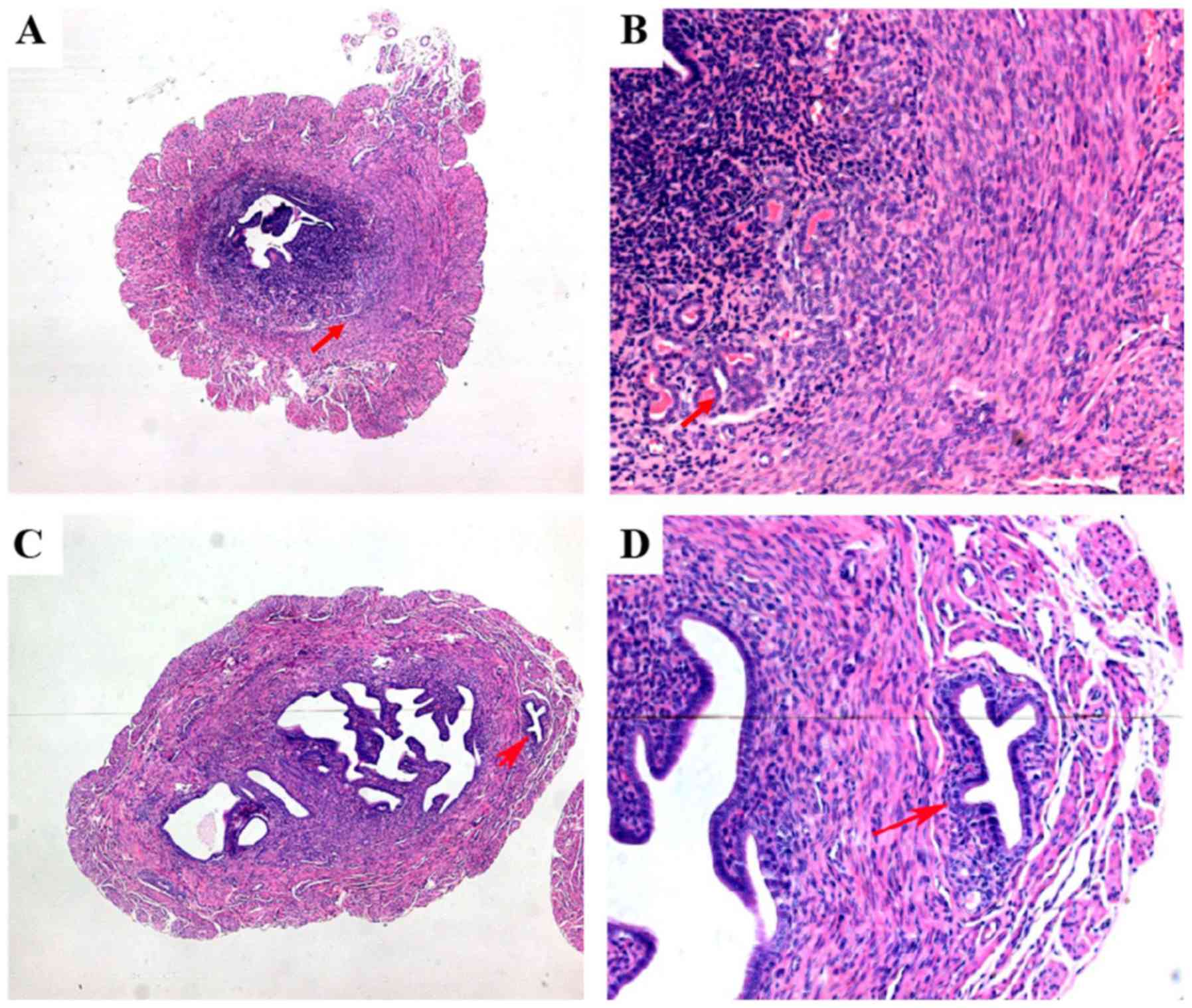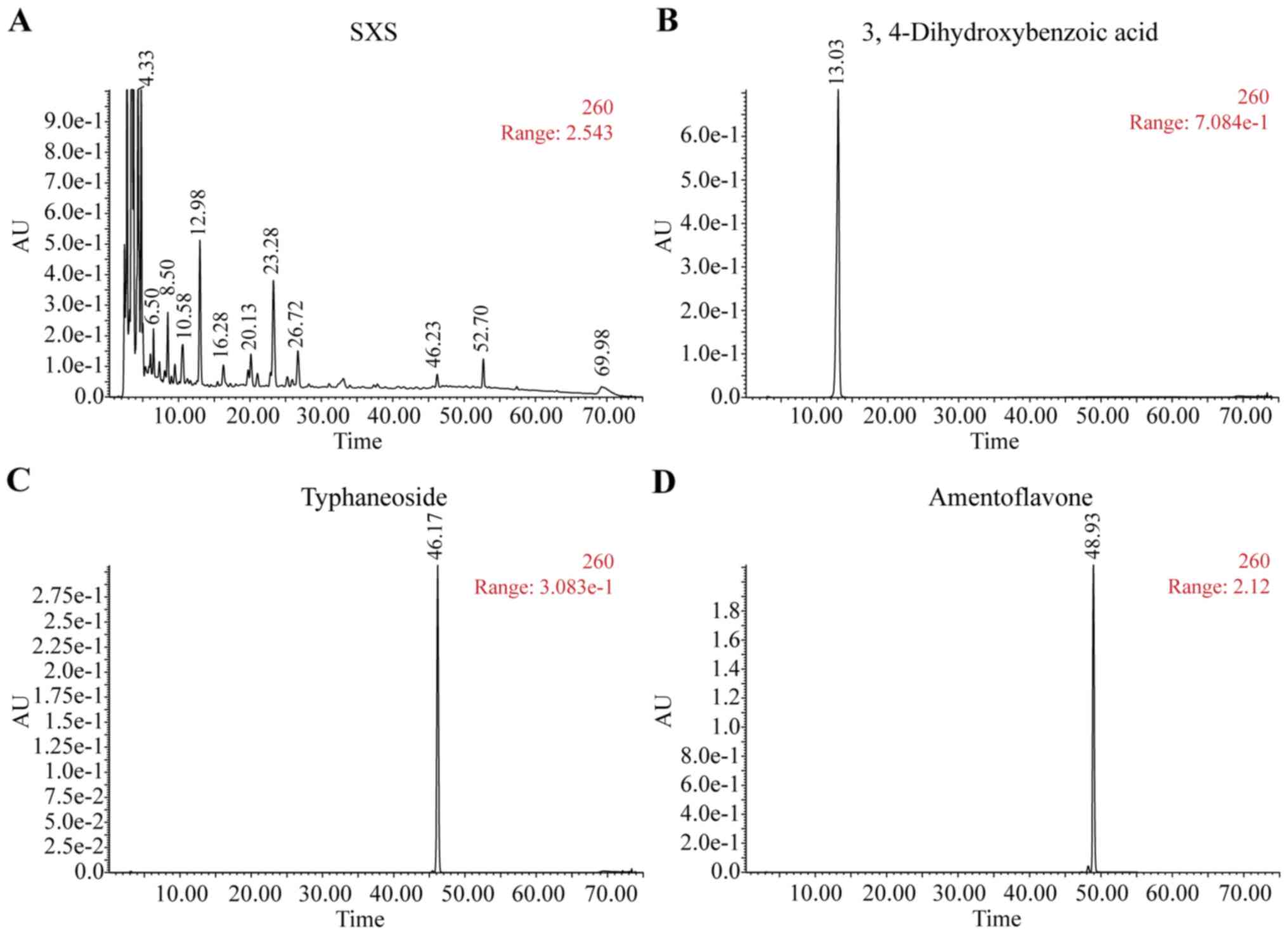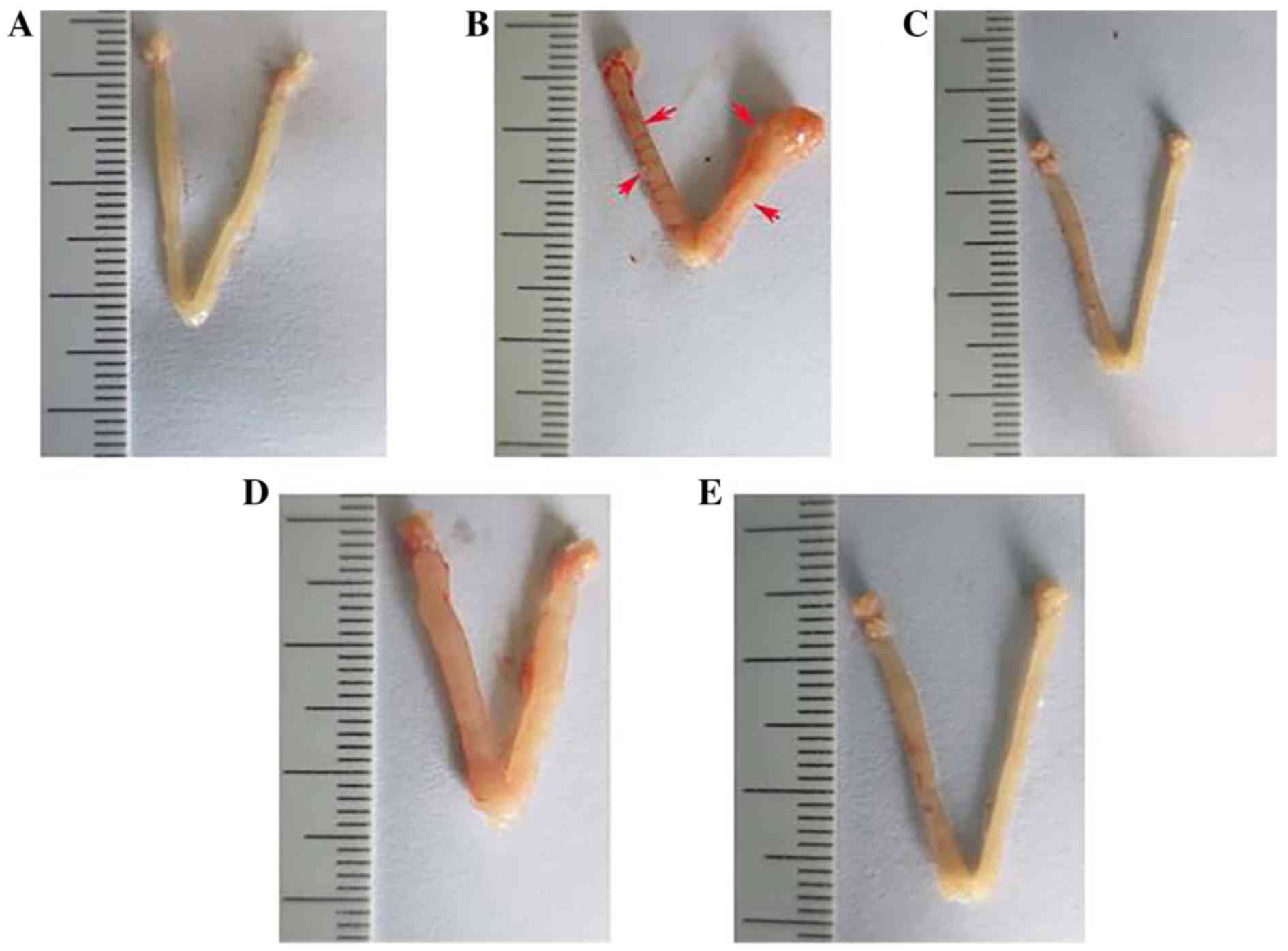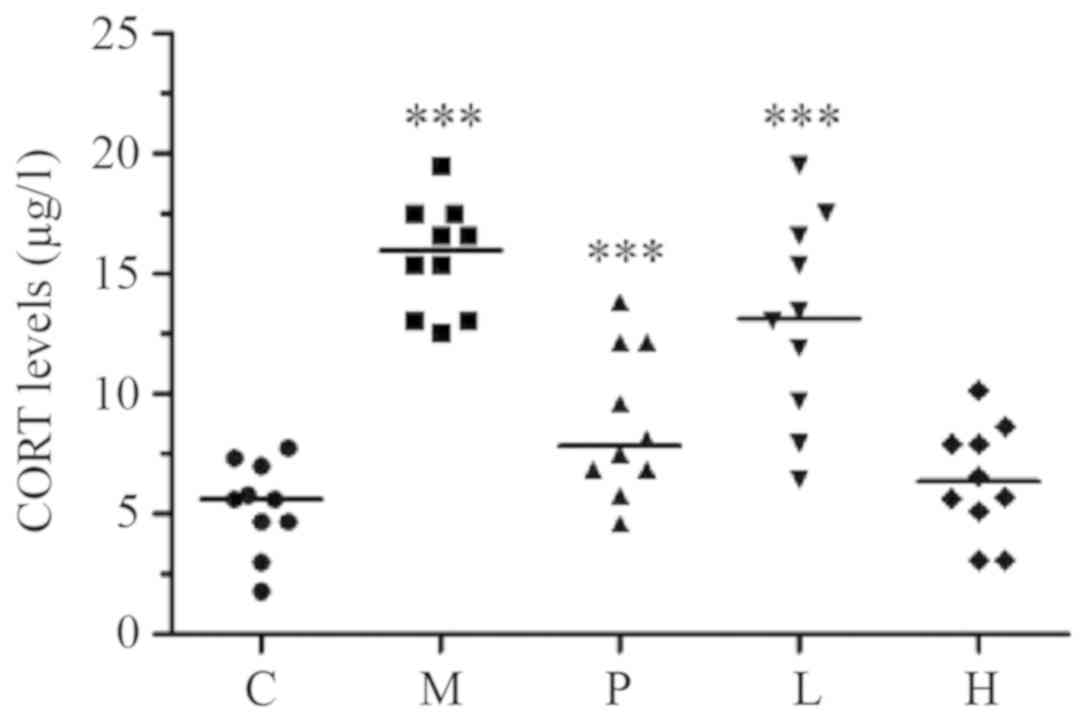|
1
|
Munro MG: Classification and reporting
systems for adenomyosis. J Minim Invasive Gynecol. 27:296–308.
2020.PubMed/NCBI View Article : Google Scholar
|
|
2
|
Yu O, Schulze-Rath R, Grafton J, Hansen K,
Scholes D and Reed SD: Adenomyosis incidence, prevalence and
treatment: United States population-based study 2006-2015. Am J
Obstet Gynecol: doi:10.1016/j.ajog.2020.01.016.
|
|
3
|
Tomassetti C, Meuleman C, Timmerman D and
D'Hooghe T: Adenomyosis and subfertility: Evidence of association
and causation. Semin Reprod Med. 31:101–108. 2013.PubMed/NCBI View Article : Google Scholar
|
|
4
|
Koike N, Tsunemi T, Uekuri C, Akasaka J,
Ito F, Shigemitsu A and Kobayashi H: Pathogenesis and malignant
transformation of adenomyosis (review). Oncol Rep. 29:861–867.
2013.PubMed/NCBI View Article : Google Scholar : (review).
|
|
5
|
Jichan Nie, Xishi Liu and Guo SW: Promoter
hypermethylation of progesterone receptor isoform B (PR-B) in
adenomyosis and its rectification by a histone deacetylase
inhibitor and a demethylation agent. Reprod Sci. 17:995–1005.
2010.PubMed/NCBI View Article : Google Scholar
|
|
6
|
Morelli M, Rocca ML, Venturella R,
Mocciaro R and Zullo F: Improvement in chronic pelvic pain after
gonadotropin releasing hormone analogue (GnRH-a) administration in
premenopausal women suffering from adenomyosis or endometriosis: A
retrospective study. Gynecol Endocrinol. 29:305–308.
2013.PubMed/NCBI View Article : Google Scholar
|
|
7
|
Bergeron C, Amant F and Ferenczy A:
Pathology and physiopathology of adenomyosis. Best Pract Res Clin
Obstet Gynaecol. 20:511–521. 2006.PubMed/NCBI View Article : Google Scholar
|
|
8
|
Grow DR and Filer RB: Treatment of
adenomyosis with long-term GnRH analogues: A case report. Obstet
Gynecol. 78:538–539. 1991.PubMed/NCBI
|
|
9
|
Saremi A, Bahrami H, Salehian P, Hakak N
and Pooladi A: Treatment of adenomyomectomy in women with severe
uterine adenomyosis using a novel technique. Reprod Biomed Online.
28:753–760. 2014.PubMed/NCBI View Article : Google Scholar
|
|
10
|
Pepas L, Deguara C and Davis C: Update on
the surgical management of adenomyosis. Curr Opin Obstet Gynecol.
24:259–264. 2012.PubMed/NCBI View Article : Google Scholar
|
|
11
|
Taran FA, Stewart EA and Brucker S:
Adenomyosis: Epidemiology, risk factors, clinical phenotype and
surgical and interventional alternatives to hysterectomy.
Geburtshilfe Frauenheilkd. 73:924–931. 2013.PubMed/NCBI View Article : Google Scholar
|
|
12
|
Hu SH, Cao BL, Liu X, et al: Drug use law
of traditional chinese medicine in treating endometriosis. West J
Tradit Chin Med. 31:87–90. 2018.(In Chinese).
|
|
13
|
Wang Y and Wei SB and Wei SB: The second
stage therapy of TCM in treating 120 cases of adenomyosis of
stagnation pattern of heat-dampness. West J Tradit Chin Med.
30:1–3. 2017.(In Chinese).
|
|
14
|
Liu Z, Li YH, Sun J, et al: Study of
usages of Shixiao powder by ancient literature. J Ethnomedicine
Ethnopharmacy. 27:7–10. 2018.
|
|
15
|
Zhou J and Qu F: Treating gynaecological
disorders with traditional Chinese medicine: A review. Afr J Tradit
Complement Altern Med. 6:494–517. 2009.PubMed/NCBI View Article : Google Scholar
|
|
16
|
Flower A, Liu JP, Lewith G, Little P and
Li Q: Chinese herbal medicine for endometriosis. Cochrane Database
Syst Rev. 5(CD006568)2012.PubMed/NCBI View Article : Google Scholar
|
|
17
|
Cheng C, Gui T, Huang MH, et al: Treatment
of adenomyosis patients by bushen huoxue sanyu decoction: A
clinical study. CJITWM. 34(11):1302–1305. 2014.PubMed/NCBI
|
|
18
|
Zhang L and Shi YP: Efficacy observation
of ultrasonic conductometric acupoint penetration of Wenhua Zhitong
recipe for adenomyosis patients. CJITWM. 36(1):54–58.
2016.PubMed/NCBI(In Chinese).
|
|
19
|
Chen Y, Zhu B, Zhang H, Liu X and Guo SW:
Epigallocatechin-3-gallate reduces myometrial infiltration, uterine
hyperactivity, and stress levels and alleviates generalized
hyperalgesia in mice induced with adenomyosis. Reprod Sci.
20:1478–1491. 2013.PubMed/NCBI View Article : Google Scholar
|
|
20
|
Mao X, Wang Y, Carter AV, Zhen X and Guo
SW: The retardation of myometrial infiltration, reduction of
uterine contractility, and alleviation of generalized hyperalgesia
in mice with induced adenomyosis by levo-tetrahydropalmatine
(l-THP) and andrographolide. Reprod Sci. 18:1025–1037.
2011.PubMed/NCBI View Article : Google Scholar
|
|
21
|
Liu X and Guo SW: Valproic acid alleviates
generalized hyperalgesia in mice with induced adenomyosis. J Obstet
Gynaecol Res. 37:696–708. 2011.PubMed/NCBI View Article : Google Scholar
|
|
22
|
Mehasseb MK, Bell SC and Habiba MA: The
effects of tamoxifen and estradiol on myometrial differentiation
and organization during early uterine development in the CD1 mouse.
Reproduction. 138:341–350. 2009.PubMed/NCBI View Article : Google Scholar
|
|
23
|
Zhang X, Yuan H, Deng L, Hu F, Ma J and
Lin J: Evaluation of the efficacy of a danazol-loaded intrauterine
contraceptive device on adenomyosis in an ICR mouse model. Hum
Reprod. 23:2024–2030. 2008.PubMed/NCBI View Article : Google Scholar
|
|
24
|
Kida H: Histological analysis of
spontaneous adenomyosis-like changes in recombinant inbred mouse
uterus (SMXA mouse)--a novel animal model for adenomyosis. Nihon
Sanka Fujinka Gakkai Zasshi. 46(4):323–330. 1994.PubMed/NCBI(In Japanese).
|
|
25
|
Yamada H, Shimada S and Fujimoto S:
Endometriosis-adenomyosis mouse model induced by transvaginal
pituitary transplantation. Nihon Rinsho. 59 (Suppl 1):221–224.
2001.PubMed/NCBI(In Japanese).
|
|
26
|
Li Y, Zhang SF, Zou SE, Xia X and Bao L:
Accumulation of nerve growth factor and its receptors in the uterus
and dorsal root ganglia in a mouse model of adenomyosis. Reprod
Biol Endocrinol. 9(30)2011.PubMed/NCBI View Article : Google Scholar
|
|
27
|
Li X, Liu X and Guo SW: Clinical profiles
of 710 premenopausal women with adenomyosis who underwent
hysterectomy. J Obstet Gynaecol Res. 40:485–494. 2014.PubMed/NCBI View Article : Google Scholar
|
|
28
|
Cirpan T, Yeniel O, Ulukus M, Ozbal A,
Gundem G, Ozsener S, Mete Itil I and Zekioglu O: Clinical symptoms
and histopathological findings in subjects with adenomyosis uteri.
Clin Exp Obstet Gynecol. 35:48–53. 2008.PubMed/NCBI
|
|
29
|
Shrestha A and Sedai LB: Understanding
clinical features of adenomyosis: A case control study. Nepal Med
Coll J. 14:176–179. 2012.PubMed/NCBI
|
|
30
|
Nie J, Liu X and Guo SW: Immunoreactivity
of oxytocin receptor and transient receptor potential vanilloid
type 1 and its correlation with dysmenorrhea in adenomyosis. Am J
Obstet Gynecol. 202:346. e1–8. 2010.PubMed/NCBI View Article : Google Scholar
|
|
31
|
Guo SW, Mao X, Ma Q and Liu X:
Dysmenorrhea and its severity are associated with increased uterine
contractility and overexpression of oxytocin receptor (OTR) in
women with symptomatic adenomyosis. Fertil Steril. 99:231–240.
2013.PubMed/NCBI View Article : Google Scholar
|
|
32
|
Taran FA, Weaver AL, Coddington CC and
Stewart EA: Understanding adenomyosis: A case control study. Fertil
Steril. 94:1223–1228. 2010.PubMed/NCBI View Article : Google Scholar
|
|
33
|
Chapman CR, Tuckett RP and Song CW: Pain
and stress in a systems perspective: Reciprocal neural, endocrine,
and immune interactions. J Pain. 9:122–145. 2008.PubMed/NCBI View Article : Google Scholar
|
|
34
|
Li SP, Zhao J and Yang B: Strategies for
quality control of Chinese medicines. J Pharm Biomed Anal.
55:802–809. 2011.PubMed/NCBI View Article : Google Scholar
|
|
35
|
Reagan-Shaw S, Nihal M and Ahmad N: Dose
translation from animal to human studies revisited. FASEB J.
22:659–661. 2008.PubMed/NCBI View Article : Google Scholar
|
|
36
|
Ascher SM, Imaoka I and Lage JM:
Tamoxifen-induced uterine abnormalities: The role of imaging.
Radiology. 214:29–38. 2000.PubMed/NCBI View Article : Google Scholar
|
|
37
|
Mori T, Yamasaki S, Masui F, Matsuda M,
Sasabe H and Zhou YF: Suppression of the development of
experimentally induced uterine adenomyosis by a novel matrix
metalloproteinase inhibitor, ONO-4817, in mice. Exp Biol Med
(Maywood). 226:429–433. 2001.PubMed/NCBI View Article : Google Scholar
|
|
38
|
Gui T, Chen C, Zhang Z, Tang W, Qian R, Ma
X, Cao P and Wan G: The disturbance of TH17-Treg cell balance in
adenomyosis. Fertil Steril. 101:506–514. 2014.PubMed/NCBI View Article : Google Scholar
|
|
39
|
Yan Li, Shaofen Zhang, Xian Xia and Enshi
Zhou: Establishment of an ICR mouse model of adenomyosis by oral
administration of Tamoxifen. Acta laboratorium animalis scientia
sinica. 17(5):345–350. 2009.(In Chinese).
|
|
40
|
Bird CC, McElin TW and Manalo-Estrella P:
The elusive adenomyosis of the uterus--revisited. Am J Obstet
Gynecol. 112:583–593. 1972.PubMed/NCBI View Article : Google Scholar
|
|
41
|
Emge LA: The elusive adenomyosis of the
uterus Its historical past and its present state of recognition. Am
J Obstet Gynecol. 83:1541–1563. 1962.PubMed/NCBI View Article : Google Scholar
|
|
42
|
Mechsner S, Bartley J, Loddenkemper C,
Salomon DS, Starzinski-Powitz A and Ebert AD: Oxytocin receptor
expression in smooth muscle cells of peritoneal endometriotic
lesions and ovarian endometriotic cysts. Fertil Steril. 83 (Suppl
1):1220–1231. 2005.PubMed/NCBI View Article : Google Scholar
|
|
43
|
Szallasi A: Vanilloid (capsaicin)
receptors in health and disease. Am J Clin Pathol. 118:110–121.
2002.PubMed/NCBI View Article : Google Scholar
|
|
44
|
Lu AP, Jia HW, Xiao C and Lu QP: Theory of
traditional Chinese medicine and therapeutic method of diseases.
World J Gastroenterol. 10:1854–1856. 2004.PubMed/NCBI View Article : Google Scholar
|
|
45
|
Garcia L and Isaacson K: Adenomyosis:
Review of the literature. J Minim Invasive Gynecol. 18:428–437.
2011.PubMed/NCBI View Article : Google Scholar
|
|
46
|
Taran FA, Weaver AL, Coddington CC and
Stewart EA: Characteristics indicating adenomyosis coexisting with
leiomyomas: A case-control study. Hum Reprod. 25:1177–1182.
2010.PubMed/NCBI View Article : Google Scholar
|
|
47
|
Levgur M, Abadi MA and Tucker A:
Adenomyosis: Symptoms, histology, and pregnancy terminations.
Obstet Gynecol. 95:688–691. 2000.PubMed/NCBI View Article : Google Scholar
|
|
48
|
Greaves P and White IN: Experimental
adenomyosis. Best Pract Res Clin Obstet Gynaecol. 20:503–510.
2006.PubMed/NCBI View Article : Google Scholar
|
|
49
|
Zhu B, Chen Y, Zhang H, Liu X and Guo SW:
Resveratrol reduces myometrial infiltration, uterine hyperactivity,
and stress levels and alleviates generalized hyperalgesia in mice
with induced adenomyosis. Reprod Sci. 22:1336–1349. 2015.PubMed/NCBI View Article : Google Scholar
|
|
50
|
Moriyama T, Higashi T, Togashi K, Iida T,
Segi E, Sugimoto Y, Tominaga T, Narumiya S and Tominaga M:
Sensitization of TRPV1 by EP1 and IP reveals peripheral nociceptive
mechanism of prostaglandins. Mol Pain. 17(1:3)2005.PubMed/NCBI View Article : Google Scholar
|
|
51
|
Nie J and Liu X: Quercetin alleviates
generalized hyperalgesia in mice with induced adenomyosis. Mol Med
Rep. 16:5370–5376. 2017.PubMed/NCBI View Article : Google Scholar
|
|
52
|
Kurtais Y, Tur BS, Elhan AH, Erdogan MF
and Yalçin P: Hypothalamic-pituitary-adrenal hormonal responses to
exercise stress test in patients with rheumatoid arthritis compared
to healthy controls. J Rheumatol. 33(8):1530–1537. 2006.PubMed/NCBI
|
|
53
|
Otake T, Ashihara M, Nishino J, Kato K,
Fukaya S and Yoshida S: Stressors and rheumatoid arthritis: Changes
in stressors with advances in therapeutic agents. Rheumatol Int.
33:887–891. 2013.PubMed/NCBI View Article : Google Scholar
|
|
54
|
Cuevas M, Flores I, Thompson KJ,
Ramos-Ortolaza DL, Torres-Reveron A and Appleyard CB: Stress
exacerbates endometriosis manifestations and inflammatory
parameters in an animal model. Reprod Sci. 19:851–862.
2012.PubMed/NCBI View Article : Google Scholar
|
|
55
|
Ji GQ, Xu M, Yin H, et al: Study on
Shixiaosan Granule on Toxicity in Rats. Acta Chinese Medicine.
6:985–988. 2017.
|
|
56
|
Li Q, Xie P, Bai CX, Cui JY, Jiang C and
Wu YS: Mechanisms of Fufang Shixiao formula for experimental
primary dysmenorrhea. Zhongguo Zhong Xi Yi Jie He Za Zhi.
36:1087–1090. 2016.PubMed/NCBI
|




















